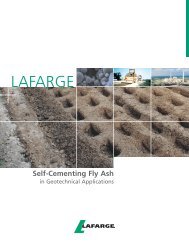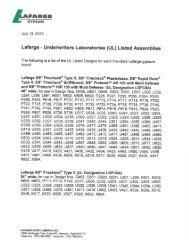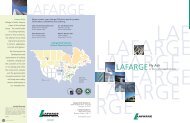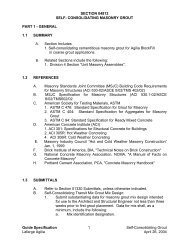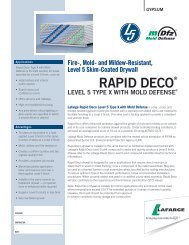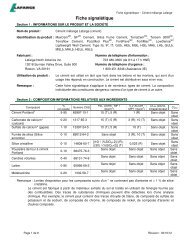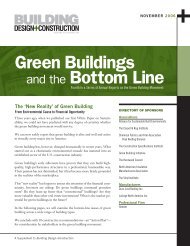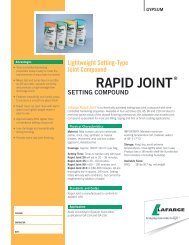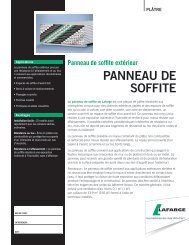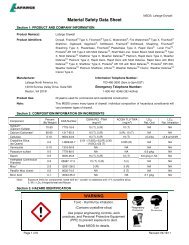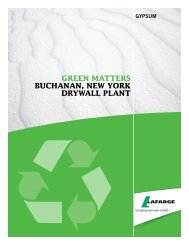Welcome
Welcome to the Neighborhood Brochure - Lafarge
Welcome to the Neighborhood Brochure - Lafarge
You also want an ePaper? Increase the reach of your titles
YUMPU automatically turns print PDFs into web optimized ePapers that Google loves.
<strong>Welcome</strong>Making an ImpressionCement made in the Bath plant can be found acrossNorth America, but a lot of it has stayed close to home.Here are a few of the more prominent projects inSoutheastern Ontario that would not have been possiblewithout cement made right here in Bath:• Kingston Police Headquarters: As part of thebuild team, Lafarge won the Sustainable ConcreteConstruction project of the year 2009. This was thefirst project in Ontario to earn LEED* Gold Certification,due to the sustainable construction practicesand concrete mixes used.• Kingston Multiplex Arena (the Invista Centre):This project used many of Lafarge’s TURBO concreteproducts including our AGILIA product in columnsand walls with tight form work and heavy re-bar whereconventional concrete would not be able to reach.• Belleville Hospital: The new wing of theBelleville Hospital includes 8,700 cubic metresof made-in-Bath cement.• CFB Trenton: The Base’s brand new control toweris standing tall thanks to 1000 cubic metres ofLafarge cement.• Wolfe Island Wind Turbines: It took 67 ReadyMix trucks to pour the concrete bases for eachof the Wolfe Island windmills.ShippingNewsDid you know that you canride your bike to Lafarge’sToronto Terminal fasterthan Lafarge’s ships?But you’d have to take300,000 trips to move thesame amount of cement.Lafarge owns a numberof ships that move cementon the water highway allaround the Great Lakesbasin. The one you’ll seethe most often is theEnglish River built in 1961.The English River has a18 person Crew including2 full time cooks. TheEnglish River ships cementto a number of LafargeTerminals, the shortest tripis to Oswego,New York at8 hours and the longest isto Whitefish, Ontario whichtakes an entire week.For more information goto www.marinetraffic.comand search for the shipof your choice.A Slow Haul through BathWhile drivers hired by our transportpartners respect the posted speedlimits on city streets and highways,when they’re in Bath we ask themto go one step further and actuallydrive below the speed limit.We do this because we know thatgoing the speed limit isn’t goodenough, especially for largervehicles. Studies show that we tendto perceive large vehicles differentlythan small vehicles. A small vehicletravelling at the speed limit may notseem like it is going fast, but a largevehicle travelling at the same speedseems like it’s whizzing by.Our vehicles tend to be bigger, sowe ask our haulers to drive slower.Did you know?Lafarge has a vibrant and activeCommunity Liaison Committeethat meets with managers fromthe Bath plant several times a year.This diverse committee acts asa two way avenue — providingfeedback to and from Lafarge.The Committee proudly representsand advocates on behalf of thedifferent sectors in our community,including local businesses,residences, and community groups.We’ve got our eyes open, watchingfor trucks that are going too fast,but we can’t catch them all. If youcatch one of our trucks speedingthrough the village, we’d like you totake down the name of the haulingcompany and the licence platenumber, if possible. Then giveus a call. We’ll take it from there.We have banned some drivers fromhauling for us. The last thing ourtransport partners want is to havetheir drivers driving improperly.So remember, if you see any truckgoing too fast for your comfort —whether it’s a Lafarge truckor someone else’s — call us at(613) 352-7711 and ask for oneof our Environmental staff.It’s all part of our commitmentto being a good neighbour.The committee also has local electedofficials and representatives fromthe Ministry of the Environmentand the Ministry of Health.To contact your localrepresentative, call the Bathplant (see contact informationat www.bathcementplant.com)or email us at LafargeBathInfo@Lafarge-na.com and we will putyou in direct touch with therepresentative of your choice.Lafarge has avibrant and activeCommunity LiaisonCommittee thatmeets with managersfrom the Bath plantseveral times ayear. This diversecommittee acts asa two way avenue —providing feedbackto and from Lafarge.Lafarge North AmericaBath Plant, Box 160Bath, ON Canada K0H 1G0Tel: (613) 352-7711 ext. 214lafargebathinfo@lafarge-na.comLafarge North America,Bath Plant is committedto being an environmentallyresponsible organization.This newsletter is printed onEnviro100 – 100% post-consumerrecycled, Environmental ChoiceCertified, Processed Chlorine Freepaper made with bio gas energyEditorRob CummingWriting contributions byEmma BuckleyDeborah Melman-ClementDesign byBmDodo Strategic Designwww.bmdodo.comPrinted byLowe Martin, Inc.to the Neighbourhood!You may have noticed us as you’ve been exploring yournew home in the beautiful Village of Bath and wonderedwhat Lafarge makes at this plant? The Lafarge Bath Plantis many things. We are a supplier of cement, an employer,a partner, a sponsor and a proud community supporter.Since it looks like we’re going to be neighbours for a quitea while, we’d like to take this opportunity to welcome youto the neighbourhood and introduce ourselves. In goodneighbourly spirit, we hope this brochure helps you getto know us, and we look forward to getting to know youin the near future.About LafargeThe Bath Cement Plant is partof Lafarge North America, oneof the Lafarge Group of Companies.We also have our very own websiteat www.bathcementplant.com.With more than 16,000 employeesat nearly 1,000 sites, Lafarge NorthAmerica is the largest diversifiedsupplier of construction materials inCanada and the U.S. We produce andsell cement, ready-mixed concrete,gypsum wallboard, aggregates,asphalt and related productsand services.Our products are used to buildhomes, apartment buildings, officebuildings, schools, hospitals,highways, roads, bridges, parks,swimming pools, wind mills, andother exciting projects across thecontinent. To learn more aboutLafarge North America visit usonline at www.lafarge-na.com.Lafarge North America is part ofthe Lafarge Group, a world leaderwith a presence in more than 75countries. To learn more aboutthe company, visit us online atwww.lafarge.com.
Bath Plant Bythe NumbersNumber of Employees:105132460Number of Firms thatContract with Us:5Amount of local taxespaid by the plant:$1,000,000Hectares of Landon Our Property:1050(>2500 Acres)Number of BricksInside Our Kiln:1,100,000Number ofCN Towersthat CanBe Madefrom thatCement:180,200Tonnes of CementMade per Year:70Dollars Invested in the Plantover the Last 10 Years:$70,000,000Annual estimatedeconomic impact:$100,000,000Dimensions of the kiln:200 m (655 ft) long5.5 m (18 ft) in diameterThe Bath PlantThe story of the Bath Cement Plantbegins in our quarry just northof the main plant. Since 1973,Lafarge employees have beenquarrying limestone, which iscrushed and carried to the plantby a 1.5-kilometre-long conveyorsystem. There the raw materialsare mixed and heated to over 1450degrees Celsius — a temperaturea quarter that of the surface of thesun — in the plant’s kiln where itbecomes clinker. When the clinkeremerges from the kiln, it is cooled,mixed with gypsum, and groundinto a fine powder knownas Portland cement.Our QuarryIn 2008, the plant opened up a newpart of the quarry on the west sideof the property. The $12,000,000project — complete with a brandnew underground conveyor system— took years to plan and almostan entire year to complete.The Bath quarry contains over100 years worth of stone.As you drive by our plant site you’llnotice “no trespassing” signs on ourfences. We want you to know thatthey’re there for everyone’s safety —not to discourage hearing from you.As a licensed quarry we are requiredto secure the site and for goodreasons. We do have large mobileequipment in use and we haveCement is stored in silos andthe dome and shipped by boat,truck, and rail to our customerswho combine our cement withwater, sand, and aggregateto make concrete.The Lafarge Bath Plant1. Cement Storage(Silos and Dome)2. Kiln3. Storage Hall4. Emission Controls5. Main Entrance.small, controlled blasts to create therock we need to make our product.These operations are very safe forour employees, and we inspect thearea prior to each blast, but its ineveryone’s interest to ensure safety.There are other reasons too.We have a lot of land which is veryisolated in parts, if someone getslost or hurt there, it may be difficultfor them to get help. We also leaseparts of our property to farmers,and out of respect for them, we askthat you join us in being a goodneighbour and limit your visitsto the plant itself during regularbusiness hours.What is Cement & Concrete?Cement is the glue thatholds concrete together,and concrete is second onlyto water in annual humanconsumption. Concreteis everywhere, so muchso that we don’t notice it,even though it’s more usedthan all other buildingmaterials combined.Concrete supports our homes,schools and hospitals. It makesit possible to span rivers, providesus with water and keeps us safeduring storms.Concrete users such as pipe makers,builders and civil contractorsdepend on the quality of thecement they receive from the Bathplant, and they need it to look andperform the same way every time.Architects don’t want wall surfacesto be different shades of grey.By design, cement productionfacilities are created withconsistency in mind, andconsistency starts with quality.Our rigorous quality controlprocess includes regular analysisof raw materials, such as crushedlimestone rocks, sand and othermaterials that go into the finishedproduct to ensure compliancewith corporate and governmentstandards.The process starts in the quarry.We design our engineered quarryblasts to create a uniform andblended mix of rock from thevarious rock types in our quarryand the mix of reagent materialsbeing fed into our kiln is exactlythe same from hour to hour andfrom day to day. Its akin to mixingrecipe ingredients in the kitchen,they need to be well mixed andthe same proportions each time.Our Marketing Department collectsand tests competitor samples tosee how we compare with them.Our customers tell us that ourcement is known as a great wellrounded performer in a widevariety of applications.Cement made in our plant isused in impressive structuresacross the continent, but it’salso available for you to usein your home and yard.You can buy a bag of Portlandcement, mix it with sand and gravel,add water, and make your ownconcrete that can be used for anynumber of projects. Or buy a bagof “ready mix” and just add water.Environmental ProgramsHome Sweet HabitatDid you know that Lafarge isthe only cement manufacturerin the world to form apartnership with one of theworld’s leading environmentalprotectors?It’s true. In 2000, Lafarge became theWorld Wide Fund for Nature (WWF)’sleading industrial conservationpartner and agreed to make a seriesof practical commitments to ensurecontinued respect for peopleand the environment.These commitments include:• Continual reductionof CO 2 emissions• Developing a plan to reducewater consumption• Increasing biodiversitywhenever possible• Promoting sustainableconstruction practices, productsand systems throughout thebuilding -construction chainThe corporation also devisedSustainability Ambitions 2012,a vehicle to extend the partnershipby setting ambitious targets forall plants to reach in the nextfew years with respect to healthand safety, CO2 emissions andquarry rehabilitation.The Bath plant shares the parentcompany’s passion for sustainabilityand brings it home in many ways,the most visible being the plant’scommitment to preserving andenhancing the lands surroundingthe property as wildlife habitats.Plant employees have earnedrecognition from the WildlifeHabitat Council for theirefforts — often on their owntime — to make these landsmore welcoming to our animalneighbours.One of their most visible effortsis a native tree and shrub plantingprogram in partnership with ScoutsCanada. These plants have been partof the ecosystem and provide foodand shelter to literally hundreds ofspecies of insects, birds and mammals,and as they are native, require far lessfertilizer and water than their nonnativecounterparts.Other initiatives includebuilding bird boxes and batboxes and planting additionalforage grasses and wildflowersto attract bees.And the Winner Is...2002 ISO 9001 Certification2004 Winner LandStewardship Award(Portland Cement Association)2004 Winner Lafarge NorthAmerica Environmental Award2004 ISO 14001 Certification2005 Winner Lafarge NorthAmerica Environmental Award2006 Wildlife HabitatCouncil Certification2006 Ducks Unlimited2007 Most Improved Plant(Lafarge Americas)2007 Wild TurkeyFederation Certification2008 Lafarge North AmericaEnvironmental Award2009 Winner OverallEnvironmental Excellence Award(Portland Cement Association)



